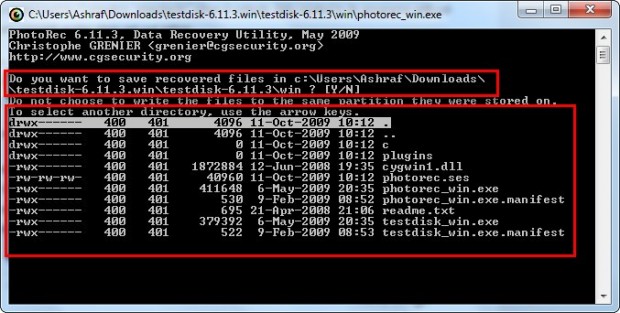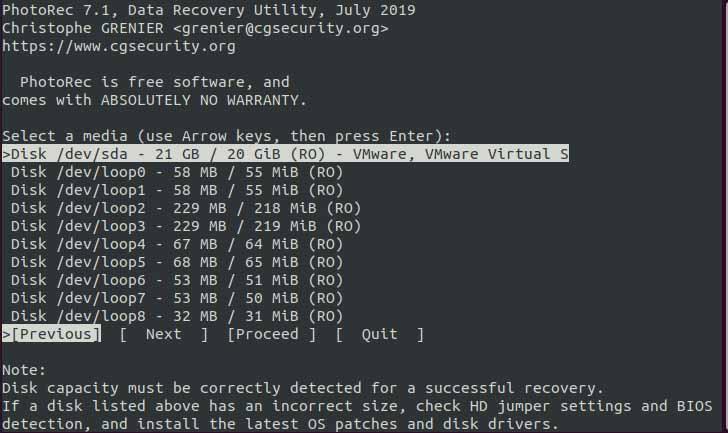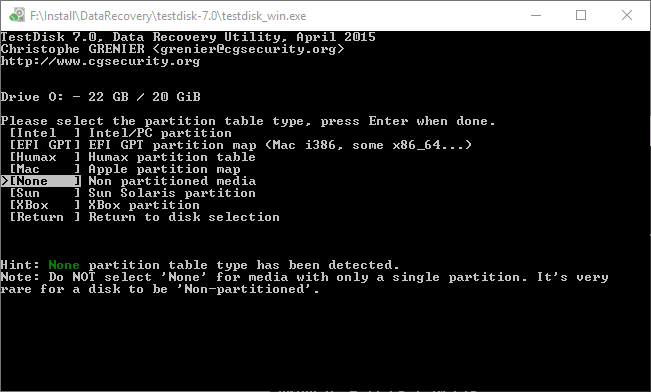
#Gui for testdisk how to#
How To Recover Deleted Files in Linux using PhotoRec?īefore we begin, we need to install PhotoRec on our Linux system. That’s not to say PhotoRec cannot be used for other file types, you sure can. That’s why the name “PhotoRec” which is short for “Photo Recovery”. PhotoRec, on the other hand, was created to recover media files that were deleted from SD Cards and other removable media. TestDisk was created by CGSecurity to recover deleted partitions. Let’s find out how to use PhotoRec to recover deleted files. In a previous tutorial, we discussed the steps to recover deleted files using a Linux utility named TestDisk and the PhotoRec utility is created by the same company. With Testdisk and a little luck, you may never lose your resume again as you can always recover deleted files in Linux.ĭisclaimer: This tutorial is a reader submission.Accidentally deleted files or photos? In this tutorial, we’ll learn how to recover deleted files in Linux using PhotoRec. But once you do find them, the copying procedure is basically the same.


Furthermore, the files you’re looking for will not appear in red since they were never deleted in the first place. Note, however, that the sequence of steps here will be a little different, you may need to use the “analyze” option for Testdisk to make sense of the drive and you may have to poke around a little to find the “home” folder once you do. Nevertheless, after a few false starts, I was able to find and save the missing files. This, among other reasons, is because most Linux file managers can no longer read ext.2 file systems. None of the usual files appear, and hunting around simply doesn’t help.
#Gui for testdisk Pc#
You can then mount it on another PC and copy the files where ever you want.īut what if the drive is formatted to LVM? This was my problem because a mounted LVM drive looks nothing like a normal Linux OS. Normally it’s simply a matter of removing said drive any hooking it up to a USB adapter. I was trying to save files from a corrupted drive that could not be made to boot. In fact, this is why I started using the program in the first place. In graphically simple environments simplicity is your friend.įinally, Testdisk can also help you retrieve files that have become inaccessible for other reasons. In other words, physically detach all other storage drives. Second, as with anything, the fewer the distractions, the easier it is to find what you’re looking for. And just like a “back” button repeating will eventually lead you back to the beginning.
#Gui for testdisk full#
This won’t close the program, instead, it will act like the “back” button on a program with a full blown GUI, and put you back a page. A few tips on recovering deleted files in Linux using TestDiskįirst, if you find yourself somewhere you don’t want to be, hit “q” for quit. Navigating in Testdisk is a little tricky, whereas dragging and dropping after the fact is a breeze. And again this is generally the best thing to do.

After hitting “c” there are options about where you might want to recover the file to, but it defaults to your home folder. Hit C to copy and thus recover the deleted fileĪs you can see from the scoreboard, we’ve won 1-0. How to recover deleted files in Linux using TestDisk Furthermore, if you can get past using a primitive GUI, it’s actually easy to do! I’ll show you how to use TestDisk to recover deleted files.

Really, don’t worry-you don’t need a lab to recover the deleted files. And one that doesn’t require an IT forensics lab.” What would really help would be a way to ‘un-delete’ files. But so far as I’m concerned if I can’t open, edit or print from it, it doesn’t exist in any practical sense. “Yes, fine” you say, “I’ll rest easy knowing my resume ‘exists’ in some abstract sense.
#Gui for testdisk free#
In fact, depending on the size of the file and the free space on your drive deleted files can persist indefinitely-even if you do write on the drive. So long as you don’t write onto the drive, it absolutely still exists. All that’s happened is that it’s been bumped off a list. “Don’t worry?” you counter, “I just erased the only copy of my resume!” And remember you’re not alone sooner or later everyone does this. Have you ever gotten that horrible feeling? The one you get when you realize that you accidentally deleted files and it’s not even in the trash? Often it is immediately preceded by denial: I know I have another copy of it somewhere.īut rather than going through all the stages of grief, don’t worry. It’s an easy to use tool that almost anyone can use to recover lost files in Ubuntu or other Linux distributions. Brief: This article shows you how to recover deleted files in Linux using command line tool Test Disk.


 0 kommentar(er)
0 kommentar(er)
